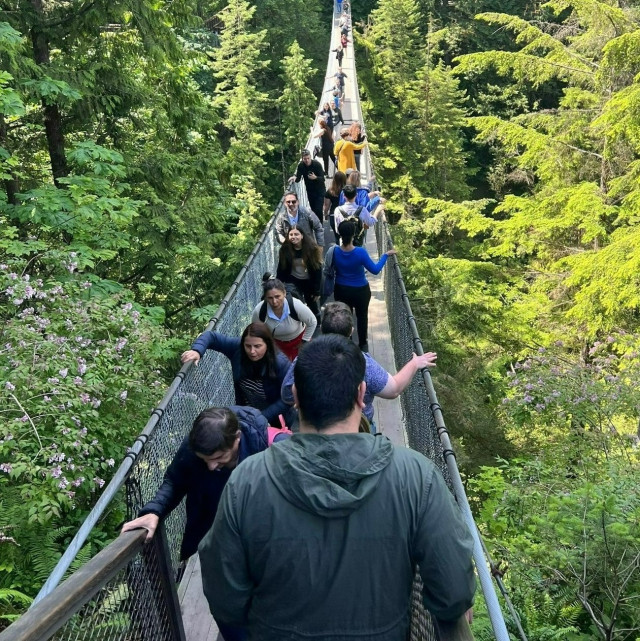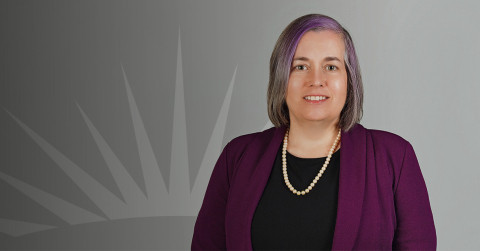
What Can a Rope Bridge Teach Us About Kindness and Hidden Struggles?
Recently, Pinnacle’s consulting actuaries met for an annual meeting, held this year in breathtaking Vancouver, British Columbia.
Beyond the usual continuing education content, team-building and social time (particularly important in a remote work environment!), I got a vivid reminder about what a truly inclusive environment means for employees with disabilities – those seen and unseen.
For one of the meeting’s afternoon activities, we went to Capilano Suspension Bridge Park (www.capbridge.com). If you’ve never been, the main attraction is an amazing cable-suspension bridge 450 feet long and hanging 230 feet above the Capilano River. At the park, there are also seven footbridges that are more than 100 feet above the forest floor, and a cliff-walk along a granite precipice.
The suspension bridge is dramatic and beautiful and a remarkable piece of engineering. But because it is a cable footbridge over a tall canyon, it inherently sways and reels side-to-side. More than a little. Quite a bit in fact. At any given time, there are scores of visitors walking across it. The wind, as well as teenagers working to get it to swing more dramatically, contributed more than their fair share to the bridge’s impressive bit of physics – and, significantly, my wariness about the whole experience.
You see, I have a genetic version of peripheral neuropathy called Charcot-Marie Tooth (CMT). CMT results in me having little or no sensation below my knees. This results in uneven sidewalks or stairs being very difficult for me to negotiate safely. I’ve literally tripped at the edge of rugs. Given my CMT, the idea of walking across a swaying bridge with a moving target for a floor had me extremely apprehensive.
This felt like a once-in-a-lifetime opportunity. I can say with pride, that with CMT, I often have to overcome physical impediments that others take for granted. So, I was determined to get across this bridge.
I let all the other Pinnacle consultants go across the bridge before I even tried. As I gingerly went across the bridge, step-by-precise-step, right hand like a vise grip on the handrail, I got more than a few curious glances. I distinctly saw looks and heard thoughts like, “Why is this guy struggling with this so much?”, “He must really be scared of heights”, and “He doesn’t look that old.” I even heard some laughs from kids as they ran past.
It struck me in that quite scary moment that this must be what people with hidden disabilities have to deal with all the time.
The Americans with Disabilities Act (ADA) defines disability quite broadly as "a physical or mental impairment that substantially limits one or more major life activities; has a record of such an impairment; or is regarded as having such an impairment."
By the ADA’s language and by the nature of many disabilities, the struggles and challenges of individuals are not always immediately obvious or visible to anyone else.
Individuals dealing with these hidden disabilities face reactions quite similar to what I experienced on the bridge, if often more direct and hurtful. They have the effect of creating more impediments to navigating an unaccommodating and, occasionally, thoughtless world. At one point, we all may have heard (or perhaps, thought?), “Why does he need that handicapped parking space? He looks fine,” or “Why do they get more breaks than everyone else?”, or “Why is she excused from this activity when the rest of us have to do it?”
All of us have struggles, some visible, some hidden. With an employer’s perspective, it reminds me to be mindful, first and foremost. That is, to be aware, and most importantly, to keep open lines of communication that can make a difference for those managing their struggles – at all levels of the organization. (Especially true with ensuring reasonable accommodations. It gives me pride to say that Pinnacle knew we had some folks that would struggle with the bridge activity and had discussed and planned alternatives.)
I really like an anonymous poem that says:
Not all scars show,
Not all wounds heal,
Often we don’t see
The pain someone feels
When dealing with hidden disabilities, communication and empathy will go a long, long way.



